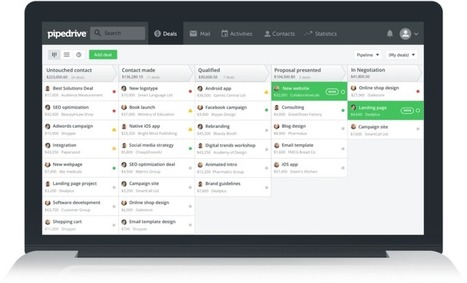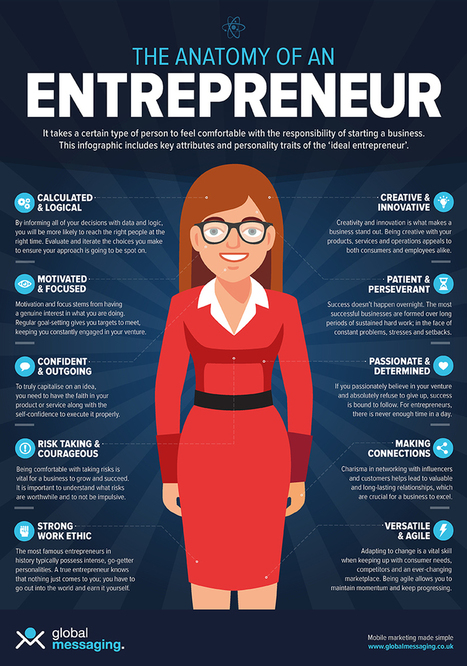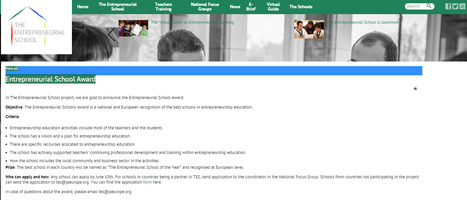 Your new post is loading...
 Your new post is loading...

|
Scooped by
Gust MEES
|
Ce qui suit est le résultat de sept années de veille : blogs, articles d’entrepreneurs et de mentors, rencontres avec des accélérateurs et incubateurs, discussions dans des communautés privées sur Facebook et Slack, listes dressées par des journalistes Tech, classements de Product Hunt… Tous ces outils ont été glanés sur internet. J’ai trouvé utile de les mettre en favoris sur Chrome pour les garder sous la main. Ils vous aideront à créer, lancer et faire grandir ce que l’écosystème appelle un MVP : une première version hyper-simplifiée de votre idée de produit, censée validée votre hypothèse (et sa viabilité économique). Certains sont plus pointus et présentent souvent un modèle freemium. Learn more / En savoir plus / Mehr erfahren: https://www.scoop.it/t/best-freeware-software

|
Scooped by
Gust MEES
|
Betonung
Betonung ist etwas entsdcheidendes für die Rede. Es kann sich der Sinn der Aussage verändern, je nachdem, welches Wort im Satz ich betone.
Ein Beispiel: "Bringen Sie mir bitte eine Tasse Kaffee!"
"Bringen Sie .." - warten Sie nicht lange, gehen Sie sofort los, schicken Sie mir niemand, der Kaffe macht, holen Sie ihn zu Fuß und bringen sie ihn mir!
"Bringen Sie ..." - lassen Sie den Kaffee nicht etwa durch einen Anderen bringen, sondern bringen Sie ihn selbst.
"Bringen Sie mir..." - bringen Sie ihn nicht dem Bronnen und keinem anderen Kollegen, sondern ausschließlich mir!
"Bringen Sie mir bitte..." - ich bin ja höflich und bitte Sie darum.
"Bringen Sie mir bitte eine..." - bitte nur eine, nicht etwa zwei, weil ich die vielleicht nicht vertrage.
"Bringen Sie mir bitte eine Tasse..." - kein Kännchen und schon gar nicht einen scheußlichen Plastik-Becher, sondern eben eine Tasse!
"Bringen Sie mir bitte eine Tasse Kaffee..." - nicht Tee und nicht Tomatensaft, sondern nur Kaffee!
Also: "Bringen Sie mir bitte eine Tasse Kaffee!"
Wenn es gelingt, wirklich jedes Wort zu betonen, wird die Sprache eindringlich, ja geradezu suggestiv. Dies ist ein Mittel, das gute Schauspieler einsetzen. Alles betonen heißt ja nicht, alles zu brüllen oder laut zu sagen, man kann auch sehr leise und gar flüsternd jedes Wort betonen. Die Kunst der richtigen Betonung ist eine geistige Anstrengung, ist die Entschiedenheit, Dinge sagen zu wollen und nur solche Dinge zu sagen, die man auch selbst versteht und unbedingt loswerden muß. Learn more / En savoir plus / Mehr erfahren: https://www.scoop.it/t/21st-century-learning-and-teaching/?&tag=Rhetorik https://www.scoop.it/t/21st-century-learning-and-teaching/?&tag=Sprechtraining

|
Scooped by
Gust MEES
|
Geldanlage über Internet-Plattformen: Hohe Rendite, mehr Risiko?
Geldanlagen über Internet-Plattformen stoßen auf wachsendes Interesse, aber auch auf Skepsis. „Die Renditen sind beim Crowdinvesting meist deutlich höher als beispielsweise auf dem Tagesgeldkonto, aber das Risiko ist auch größer“, sagte Wolf Brandes, Finanzmarktwächter bei der Verbraucherzentrale Hessen, der Deutschen Presse-Agentur. Nach Beobachtung der Verbraucherschützer werden Zinsen von durchschnittlich 4,5 Prozent geboten, in der Spitze sind es zehn Prozent.
„Anleger sollten die Risiken und Chancen und insbesondere die Ausgestaltung der Verträge genau prüfen“, mahnte Brandes. „Das Risiko reicht bis zum Totalverlust des Geldes im Falle einer Insolvenz.“ Internetplattformen sammeln dabei Geld zum Beispiel zur Finanzierung vor allem von Startups. Ist die Firma erfolgreich, erhalten Anleger Zinsen oder eine Gewinnbeteiligung. Häufig handelt es sich den Angaben zufolge um Nachrangdarlehen - im Falle einer Insolvenz bekommen die Investoren ihr Geld also erst, wenn alle anderen Gläubiger ausbezahlt wurden - oder erfolgsabhängige Darlehen.
Learn more / En savoir plus / Mehr erfahren: https://www.scoop.it/t/21st-century-learning-and-teaching/?&tag=Crowdfunding

|
Scooped by
Gust MEES
|

|
Scooped by
Gust MEES
|
Have you got what it takes to be an entrepreneur? It takes a special set of skills to make it on your own in business and that’s why only a select few succeed. We’ve taken a look at what character traits and talents are required in our guide to the anatomy of an entrepreneur. If you match this description then you’ve got a great chance of making it big… Learn more / En savoir plus / Mehr erfahren: http://www.scoop.it/t/21st-century-learning-and-teaching/?tag=Entrepreneurs

|
Scooped by
Gust MEES
|
The Virtual Guide to Entrepreneurial Learning is a practical and useful tool for teachers in primary, secondary and vocational schools that want to mainstream entrepreneurial education in teaching methods and learning processes they set up in classroom every day. The guide contains more than 100 tools and methods to support entrepreneurial teaching and learning, good practices and framework documents from 85 different schools in 10 countries. Learn more / En savoir plus / Mehr erfahren: http://www.scoop.it/t/21st-century-learning-and-teaching/?tag=Entrepreneurs

|
Scooped by
Gust MEES
|
The Entrepreneurial School will train over 4000 teachers in the next 3 years across 18 countries. The consortium will produce a Virtual Guide to Entrepreneurial Learning with 75-100 entrepreneurial tools and methods organized in 35 teacher-friendly...

|
Scooped by
Gust MEES
|
Through entrepreneurship education, young people learn organizational skills, including time management, leadership development and interpersonal skills, all of which are highly transferable skills sought by employers. According to a report by the D.C. Children and Youth Investment Corporation, other positive outcomes include:
- improved academic performance, school attendance; and educational attainment
- increased problem-solving and decision-making abilities
- improved interpersonal relationships, teamwork, money management, and public speaking skills
- job readiness
- enhanced social psychological development (self-esteem, ego development, self-efficacy), and
- perceived improved health status

|
Scooped by
Gust MEES
|
Editor's note: This post is part of a three-week series examining educational innovation and technology, published in partnership with the Advanced Leadership Initiative at Harvard University. If we can match highly-effective educators with great entrepreneurs and if we can direct smart capital toward these projects, the market for technological innovation might just spurt from infancy into adolescence. That maturation would finally bring millions of America's students the much-touted yet much-delayed benefits of the technology revolution in education.
|

|
Scooped by
Gust MEES
|
Lateral thinking is solving problems through an indirect and creative approach, using reasoning that is not immediately obvious and involving ideas that may not be obtainable by using only traditional step-by-step logic. The term was promulgated in 1967 by Edward de Bono.
Lateral thinking is solving problems through an indirect and creative approach, using reasoning that is not immediately obvious and involving ideas that may not be obtainable by using only traditional step-by-step logic. The term was promulgated in 1967 by Edward de Bono. He cites as an example the Judgment of Solomon, where King Solomon resolves a dispute over the parentage of a child by calling for the child to be cut in half, and making his judgment according to the reactions that this order receives.[2] Edward de Bono also links lateral thinking with humour, arguing there's a switchover from a familiar pattern to a new, unexpected one. It is in this moment of surprise that generates laughter and new insight which demonstrates an ability to see a different thought pattern that initially was not obvious.[3]
According to de Bono, lateral thinking deliberately distances itself from the standard perception of creativity as "vertical" logic (the classic method for problem solving).
To understand lateral thinking, it is necessary to compare lateral thinking and critical thinking. Critical thinking is primarily concerned with judging the true value of statements and seeking errors. Lateral thinking is more concerned with the "movement value" of statements and ideas. A person uses lateral thinking to move from one known idea to creating new ideas. Edward de Bono defines four types of thinking tools:
idea-generating tools intended to break current thinking patterns—routine patterns, the status quo
focus tools intended to broaden where to search for new ideas
harvest tools intended to ensure more value is received from idea generating output
treatment tools that promote consideration of real-world constraints, resources, and support
Learn more / En savoir plus / Mehr erfahren: https://www.scoop.it/t/21st-century-learning-and-teaching/?&tag=Entrepreneurs

|
Scooped by
Gust MEES
|
Die richtige Betonung beim Sprechen
Wir sagen viel, dennoch ist nicht alles gleich wichtig.
Was ist damit gemeint „Die richtige Betonung“? Beim Sprechen ist es wichtig, den Ton auf vereinzelte Wörter oder Halbsätze zu legen.
Wenn Sie einen Text schreiben machen Sie das auch. Sie verwenden Überschriften, Fettdruck, unterstreichen Wörter etc. und eigentlich können Sie das in der Regel auch beim Sprechen anwenden, aber wie geht das?
Machen Sie doch einmal eine kleine Übung:
Nehmen Sie sich einen Text der fettgedruckte Stellen, Unterstreichungen etc. aufweist zur Hand und üben Sie – wichtig ist, daß Sie laut lesen. Die hervorgehobenen Wörter sprechen Sie in erster Linie klar und mit leicht erhobener Stimme, wobei Sie kurze davor und danach einfügen. Vielleicht hilft es Ihnen das Wort zu betonen wenn Sie dies mit einer Geste wie z.B. Hand heben unterstreichen.
Wiederholen Sie den gleichen Text und achten Sie bewusst darauf, wie sich mit der jeweiligen Betonung auch der Inhalt verändert. Durch die richtige Betonung ist es Ihnen möglich, mit dem gleichen Satz unterschiedliche Aussagen zu machen. Ihre Zuhörer werden sofort merken welches der wichtige Inhalt des Gesagten ist. Denn ist es nicht so, daß Sie auch beim Lesen das Fettgedruckte besser wahrnehmen?
Durch die richtige Betonung werden auch Mißverständnisse vermieden. Ihre Rede kommt präzise an und den Zuhörern ist es leichter möglich, aufmerksam zu folgen und vor allen Dingen alles richtig zu verstehen. Eine freie Interpretation wird vermieden. Geben Sie den Kernaussagen Sinn und Bedeutung.
Häufig denken Sprecher, daß sie richtig betonen. Dies ist jedoch in den meisten Fällen ein Trugschluss. Betonen Sie falsch ist die Wahrscheinlichkeit groß, daß jeder das Gesagte für sich selbst deutet, was wiederum zur Folge hat, daß Sie falsch verstanden werden bzw. Ihre Botschaft nicht richtig ankommt, der Inhalt ein anderer wird.
Learn more / En savoir plus / Mehr erfahren: https://www.scoop.it/t/21st-century-learning-and-teaching/?&tag=Rhetorik

|
Scooped by
Gust MEES
|
Crowdfunding is by definition, “the practice of funding a project or venture by raising many small amounts of money from a large number of people, typically via the Internet.” Check out this video to get a clearer idea of the step by step process of crowdfunding.
In a seemingly nonstop recession wave, small businesses are struggling more than ever to stay afloat, and entrepreneurs are not facing great odds. Crowdfunding offers these individuals a chance at success, by showcasing their businesses and projects to the entire world.
There are numerous donation crowdfunding platforms where entrepreneurs can safely ask for capital such as Kickstarter, Indiegogo, RocketHub, and investment platforms like 1000 Angels, the company I co-founded, to name a few. While each site offers their unique spin, the general concept is the same across the board. Project creators can create a profile typically containing a short video, an introduction to their project, a list of rewards per donation, and some images to elaborate. The idea is to create a compelling message that readers will be drawn towards. Learn more / En savoir plus / Mehr erfahren: http://www.scoop.it/t/21st-century-learning-and-teaching/?&tag=Crowdfunding

|
Scooped by
Gust MEES
|

|
Scooped by
Gust MEES
|
Honesty, transparency and authenticity can be vital to the success of your business.
In this video, Entrepreneur Network partner Salma Jafri discusses the 12 things you should not be doing if you want to be authentic on social media.
It's important to develop relationships with your customers, so if you are pitching to a new follower or fan, you're missing the point. Asking your customers questions and engaging is a great way to better the customer experience. Doing poor automation such as blasting direct messages to followers also shows you're not putting in enough effort to connect with clients.
Being consistent with your words, changing up content for various social channels and reporting on news that is relevant to your industry are a number of ways you can start being authentic on social media.
To learn more, click play. Learn more / En savoir plus / Mehr erfahren: http://www.scoop.it/t/21st-century-learning-and-teaching/?tag=Entrepreneurs

|
Scooped by
Gust MEES
|

|
Suggested by
Jeff See
|
VideoI gave a TEDx talk on student entrepreneurship recently. It sort of sums up how I feel about the extraordinary opportunity student entrepreneurs have at their disposal in this day and age.
|



 Your new post is loading...
Your new post is loading...



























Ce qui suit est le résultat de sept années de veille : blogs, articles d’entrepreneurs et de mentors, rencontres avec des accélérateurs et incubateurs, discussions dans des communautés privées sur Facebook et Slack, listes dressées par des journalistes Tech, classements de Product Hunt…
Tous ces outils ont été glanés sur internet. J’ai trouvé utile de les mettre en favoris sur Chrome pour les garder sous la main. Ils vous aideront à créer, lancer et faire grandir ce que l’écosystème appelle un MVP : une première version hyper-simplifiée de votre idée de produit, censée validée votre hypothèse (et sa viabilité économique). Certains sont plus pointus et présentent souvent un modèle freemium.
Learn more / En savoir plus / Mehr erfahren:
https://www.scoop.it/t/best-freeware-software